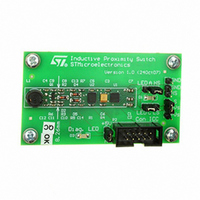STEVAL-IFS006V1 STMicroelectronics, STEVAL-IFS006V1 Datasheet - Page 51

STEVAL-IFS006V1
Manufacturer Part Number
STEVAL-IFS006V1
Description
BOARD EVAL 8BIT MICRO + TDE1708
Manufacturer
STMicroelectronics
Datasheets
1.TDE1708DFT.pdf
(14 pages)
2.STEVAL-IFS006V1.pdf
(136 pages)
3.STEVAL-IFS006V1.pdf
(4 pages)
Specifications of STEVAL-IFS006V1
Design Resources
STEVAL-IFS006V1 Bill of Material
Sensor Type
Proximity
Interface
I²C
Voltage - Supply
6 V ~ 48 V
Embedded
Yes, MCU, 8-Bit
Utilized Ic / Part
ST7FLITEUS5, TDE1708
Processor To Be Evaluated
ST7LITEUS5
Data Bus Width
8 bit
Operating Supply Voltage
6 V to 48 V
Silicon Manufacturer
ST Micro
Silicon Core Number
TDE1708DFT
Kit Application Type
Sensing - Touch / Proximity
Application Sub Type
Proximity Switch
Kit Contents
Board
Rohs Compliant
Yes
Lead Free Status / RoHS Status
Lead free / RoHS Compliant
Sensitivity
-
Sensing Range
-
Lead Free Status / Rohs Status
Lead free / RoHS Compliant
Other names
497-6403
STEVAL-IFS006V1
STEVAL-IFS006V1
Available stocks
Company
Part Number
Manufacturer
Quantity
Price
ST7LITEUS2, ST7LITEUS5
8.4.1
Caution:
Active-halt mode
Active-halt mode is the lowest power consumption mode of the MCU with a real time clock
available. It is entered by executing the ‘HALT’ instruction when Active-halt mode is enabled.
The MCU can exit Active-halt mode on reception of a Lite Timer / AT Timer interrupt or a
reset.
●
●
When entering Active-halt mode, the I bit in the CC register is cleared to enable interrupts.
Therefore, if an interrupt is pending, the MCU wakes up immediately.
In Active-halt mode, only the main oscillator and the selected timer counter (LT/AT) are
running to keep a wakeup time base. All other peripherals are not clocked except those
which get their clock supply from another clock generator (such as external or auxiliary
oscillator).
As soon as Active-halt is enabled, executing a HALT instruction while the watchdog is active
does not generate a reset if the WDGHALT bit is reset.
This means that the device cannot spend more than a defined delay in this power saving
mode.
Figure 21. Active-halt timing overview
When exiting Active-halt mode by means of a reset, a 64 CPU cycle delay occurs. After
the start up delay, the CPU resumes operation by fetching the reset vector which woke
it up (see
When exiting Active-halt mode by means of an interrupt, the CPU immediately resumes
operation by servicing the interrupt vector which woke it up (see
Figure
22).
[Active-halt Enabled]
INSTRUCTION
Run
HALT
Active
halt
CYCLE DELAY
INTERRUPT
64 CPU
RESET
OR
1)
VECTOR
FETCH
Run
Power saving modes
Figure
22).
51/136





















